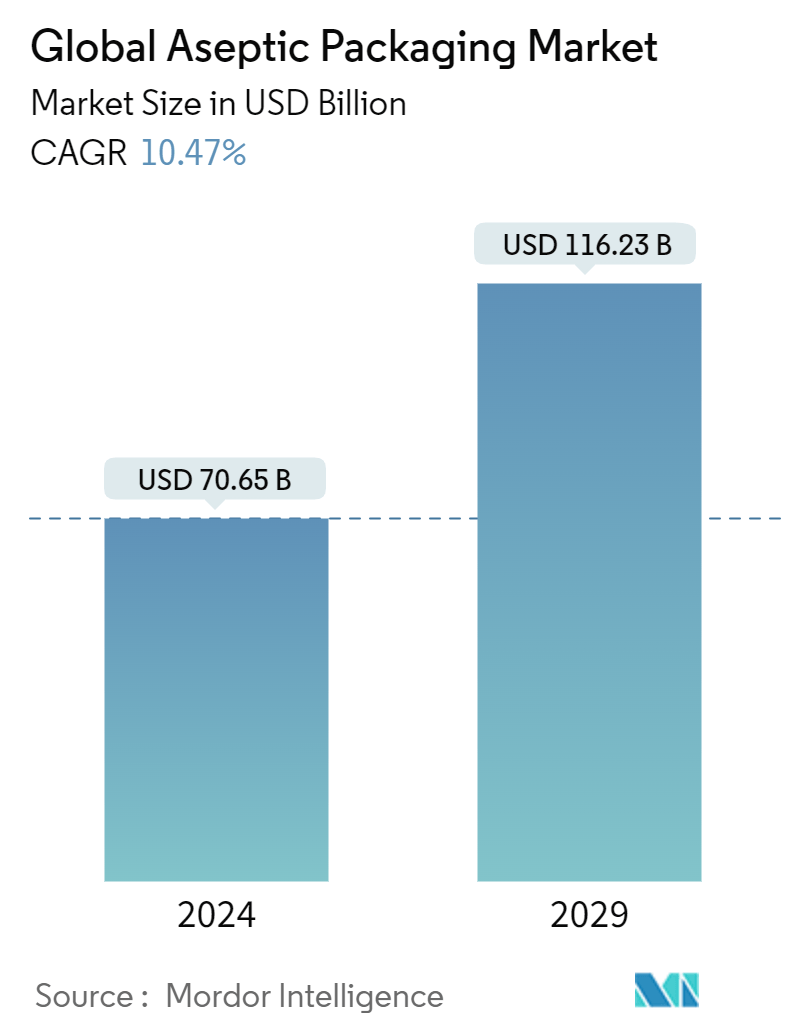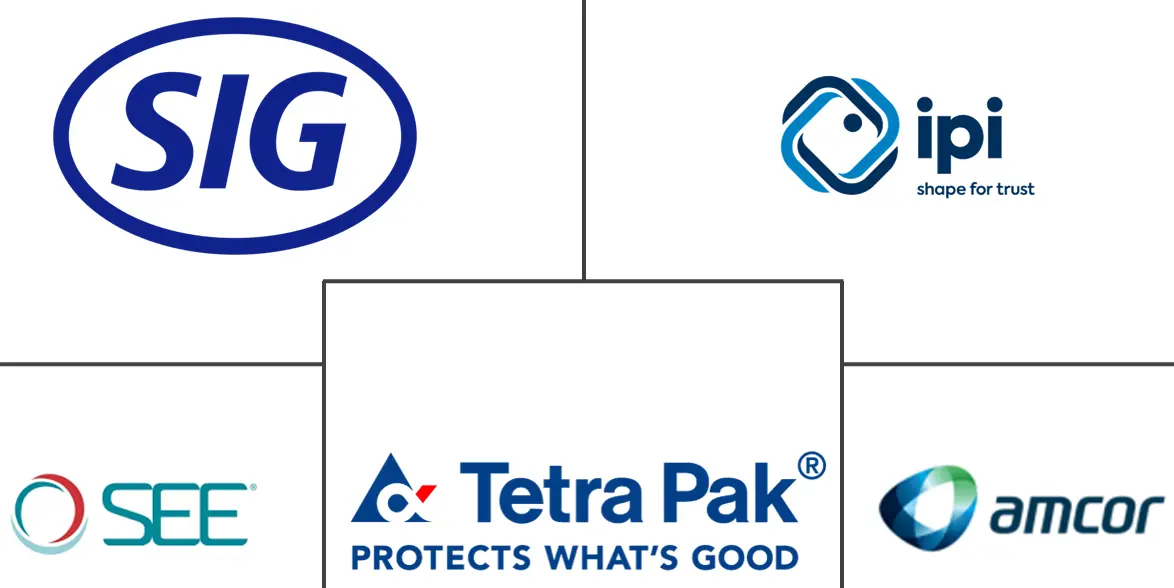Market Size of Global Aseptic Packaging Industry

| Study Period | 2019 - 2029 |
| Market Size (2024) | USD 70.65 Billion |
| Market Size (2029) | USD 116.23 Billion |
| CAGR (2024 - 2029) | 10.47 % |
| Fastest Growing Market | Asia Pacific |
| Largest Market | Asia Pacific |
Major Players
*Disclaimer: Major Players sorted in no particular order |
Aseptic Packaging Market Analysis
The Global Aseptic Packaging Market size is estimated at USD 70.65 billion in 2024, and is expected to reach USD 116.23 billion by 2029, growing at a CAGR of 10.47% during the forecast period (2024-2029).
- Aseptic packaging involves packaging a product at ultra-high temperature (UHT), sterilizing or sanitizing the packaging separately, and fusing and sealing under sterile atmospheric conditions to avoid viral and bacterial contamination. In addition, it maintains the quality of the package contents and does not require preservatives.
- Sustainable packaging and longer shelf life are essential to consumers in the food and beverage industry. As a result, most food and beverage vendors are inclining toward aseptic packaging due to its cost and environmental benefits. Also, as aseptic packaging supports packaging through recyclable cartons and eco-friendly pouches and bags, which often target consumers that prefer small-quantity packaging and make purchases more frequently, the demand for such products is considerably high worldwide.
- Changing consumer eating habits is increasing the preference for ready-to-eat meals and demand for convenient, high-quality food products, opening more doors for market growth. A gradual increase in global e-commerce sales and growth opportunities in emerging markets is anticipated to present significant opportunities for the sterile packaging market during the forecast period.
- The pharmaceutical industry utilizes aseptic pouches for packaging liquid medications, IV drugs, and other sterile products. Factors driving the growth of the aseptic packaging market include a rising need for biologics and vaccines. The demand is primarily due to the requirement for maintaining sterility and extending shelf life.
- The surge in mergers and acquisitions within the aseptic packaging market signals the strategies of market players to consolidate and capitalize on evolving consumer demands for safe and convenient packaging solutions. For instance, in October 2023, Shandong NewJF Technology Packaging Co. Ltd (NEWJF), a Chinese aseptic packaging enterprise, completed the acquisition of a 28.22% stake in Greatview Aseptic Packaging. This was intended to elevate NEWJF's position in liquid product packaging by enhancing market presence, streamlining operations, and fostering innovations in the rapidly growing market.
Aseptic Packaging Industry Segmentation
Aseptic packaging involves sterilizing food, pharmaceuticals, or other contents independently of their packaging. Subsequently, these sterilized contents are placed into containers within a sterile environment. The report tracks consumer demand based on the sales of aseptic packaging products like cartons, bags, pouches, cans, and bottles offered by various vendors operating in the market. The report also considers the prevalent base scenarios, key themes, and end user vertical-related demand cycles.
The global aseptic packaging market is segmented by product (cartons, bags and pouches, cans, bottles, and other products), application (beverages (ready-to-drink, dairy-based beverages, and other beverages), food (processed foods, fruits and vegetables, dairy food, and other foods), pharmaceutical, and other applications) and geography (North America (the United States and Canada), Europe (Germany, United Kingdom, France, Italy, and Rest of Europe), Asia-Pacific (China, India, Japan, and Rest of Asia-Pacific), Latin America (Brazil, Argentina, and Rest of Latin America), and the Middle East and Africa (United Arab Emirates, Saudi Arabia, South Africa, and Rest of the Middle East and Africa). The market sizes and forecasts are provided in terms of value (USD) for all the above segments.
| By Product | |
| Cartons | |
| Bags and Pouches | |
| Cans | |
| Bottles |
| By Application | |||||
| |||||
| |||||
| Pharmaceuticals |
| By Geography*** | ||||||
| ||||||
| ||||||
| ||||||
| Australia and New Zealand | ||||||
| ||||||
|
Global Aseptic Packaging Market Size Summary
The aseptic packaging market is poised for significant growth, driven by its ability to maintain product quality without the need for preservatives, making it increasingly popular in the food and beverage industry. This packaging method, which involves sterilizing the packaging separately and sealing it under sterile conditions, is favored for its sustainability and longer shelf life. The rising consumer demand for convenient, ready-to-eat meals and the growing trend of e-commerce are further propelling the market. In the pharmaceutical sector, the need for biologics and vaccines is boosting the demand for aseptic packaging, as it ensures sterility and extends the shelf life of products. The market is also witnessing a wave of mergers and acquisitions as companies strive to enhance their market presence and innovate in response to evolving consumer preferences.
In the Asia-Pacific region, countries like China, Japan, Australia, and India are key players in the aseptic packaging market, driven by their expanding food and beverage sectors. The increasing consumption of bottled water, beverages, and dairy products, along with the trend towards packed meals and convenience foods, is fueling market growth. Major players in the industry, such as Amcor Ltd, Tetra Pak International SA, and SIG Combibloc Group, are focusing on strategic collaborations and technological advancements to expand their market share and product offerings. Innovations like paper-based barriers and on-the-go carton packs are being introduced to meet the rising demand for sustainable and convenient packaging solutions.
Global Aseptic Packaging Market Size - Table of Contents
-
1. MARKET INSIGHTS
-
1.1 Market Overview
-
1.2 Industry Value Chain Analysis
-
1.3 Industry Attractiveness - Porter's Five Forces Analysis
-
1.3.1 Bargaining Power of Suppliers
-
1.3.2 Bargaining Power of Buyers
-
1.3.3 Threat of New Entrants
-
1.3.4 Threat of Substitute Products and Services
-
1.3.5 Intensity of Competitive Rivalry
-
-
1.4 Aseptic Packaging for Beverages - Demand Insights
-
-
2. MARKET SEGMENTATION
-
2.1 By Product
-
2.1.1 Cartons
-
2.1.2 Bags and Pouches
-
2.1.3 Cans
-
2.1.4 Bottles
-
-
2.2 By Application
-
2.2.1 Beverage
-
2.2.1.1 Ready-to-drink Beverages
-
2.2.1.2 Dairy-based Beverages
-
-
2.2.2 Food
-
2.2.2.1 Processed Food
-
2.2.2.2 Fruits and Vegetables
-
2.2.2.3 Dairy Food
-
-
2.2.3 Pharmaceuticals
-
-
2.3 By Geography***
-
2.3.1 North America
-
2.3.1.1 United States
-
2.3.1.2 Canada
-
-
2.3.2 Europe
-
2.3.2.1 Germany
-
2.3.2.2 United Kingdom
-
2.3.2.3 France
-
2.3.2.4 Italy
-
-
2.3.3 Asia
-
2.3.3.1 China
-
2.3.3.2 India
-
2.3.3.3 Japan
-
-
2.3.4 Australia and New Zealand
-
2.3.5 Latin America
-
2.3.5.1 Brazil
-
2.3.5.2 Argentina
-
-
2.3.6 Middle East and Africa
-
2.3.6.1 United Arab Emirates
-
2.3.6.2 Saudi Arabia
-
2.3.6.3 South Africa
-
-
-
Global Aseptic Packaging Market Size FAQs
How big is the Global Aseptic Packaging Market?
The Global Aseptic Packaging Market size is expected to reach USD 70.65 billion in 2024 and grow at a CAGR of 10.47% to reach USD 116.23 billion by 2029.
What is the current Global Aseptic Packaging Market size?
In 2024, the Global Aseptic Packaging Market size is expected to reach USD 70.65 billion.

